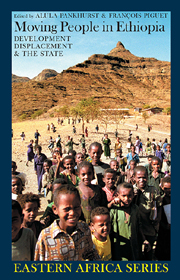Book contents
- Frontmatter
- Contents
- Acknowledgements
- Acronyms
- Glossary
- Notes on Contributors
- Preface: An Original Contribution to Country-wide Displacement Analysis
- Foreword by Alula Pankhurst & François Piguet
- Map
- Part I INTRODUCTION
- Part II THEORETICAL & INTERNATIONAL PERSPECTIVES
- Part III DEVELOPMENT-INDUCED DISPLACEMENT
- Part IV THE EXPERIENCE OF STATE-ORGANIZED RESETTLEMENT
- Part V THE DILEMMAS OF REFUGEES, RETURNEES & DISPLACED GROUPS
- 12 In the Mouth of the Lion
- 13 Returnees' Experiences of Resettlement in Humera
- 14 War, Displacement & Coping
- 15 From Young Soldiers to Adult Civilians
- Part VI CONCLUSION
- Bibliography
- Index
- EASTERN AFRICAN STUDIES
15 - From Young Soldiers to Adult Civilians
from Part V - THE DILEMMAS OF REFUGEES, RETURNEES & DISPLACED GROUPS
Published online by Cambridge University Press: 05 April 2013
- Frontmatter
- Contents
- Acknowledgements
- Acronyms
- Glossary
- Notes on Contributors
- Preface: An Original Contribution to Country-wide Displacement Analysis
- Foreword by Alula Pankhurst & François Piguet
- Map
- Part I INTRODUCTION
- Part II THEORETICAL & INTERNATIONAL PERSPECTIVES
- Part III DEVELOPMENT-INDUCED DISPLACEMENT
- Part IV THE EXPERIENCE OF STATE-ORGANIZED RESETTLEMENT
- Part V THE DILEMMAS OF REFUGEES, RETURNEES & DISPLACED GROUPS
- 12 In the Mouth of the Lion
- 13 Returnees' Experiences of Resettlement in Humera
- 14 War, Displacement & Coping
- 15 From Young Soldiers to Adult Civilians
- Part VI CONCLUSION
- Bibliography
- Index
- EASTERN AFRICAN STUDIES
Summary
Introduction
After involvement in an internal conflict for two decades, the Ethiopian People's Revolutionary Democratic Front (EPRDF) overthrew the Derg regime (1974-91). The EPRDF army as a national defence force replaced the army that served in the Derg government and a programme was launched to facilitate the return of the exsoldiers to civilian life. In June 1991, the EPRDF-led Transitional Government of Ethiopia established an institution called the Commission for the Rehabilitation of Members of the Former Army and Disabled War Veterans (CRMFADWV).
The Commission was given responsibility for the demobilization and reintegration of the ex-servicemen. Among the estimated 500,000 ex-soldiers, 326,338 were registered for institutional support in their transition. Some 156,710 preferred to assume urban life, 42,914 of whom settled in Addis Ababa. Different types of reintegration supports were provided including: return to their former employment, vocational training, certification of military skills to be useful in civilian activities, and credit schemes. Among those who settled in Addis Ababa about 1755 are engaged in 79 different cooperatives. Field research was based on two Addis Ababa cooperatives, one involving women who are engaged in food processing and the other men employed in household and office furniture production.
- Type
- Chapter
- Information
- Moving People in EthiopiaDevelopment, Displacement and the State, pp. 234 - 245Publisher: Boydell & BrewerPrint publication year: 2009



